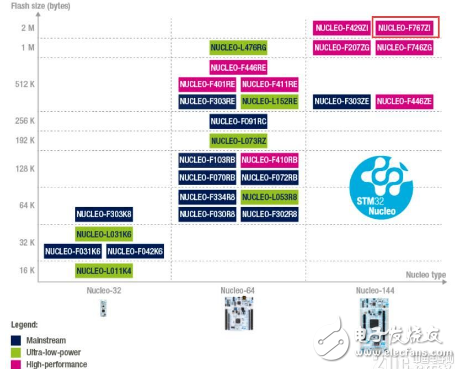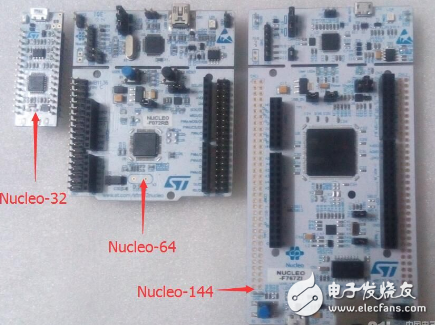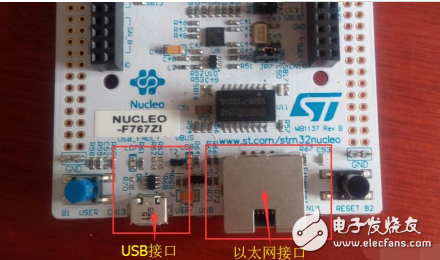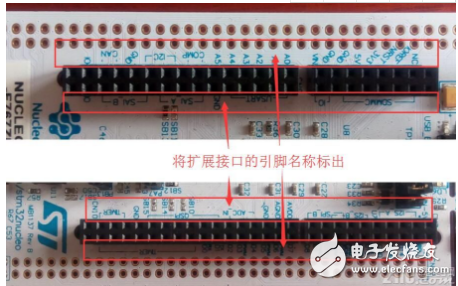The NUCLEO-F767ZI is a low-cost Nucleo evaluation board from STMicroelectronics. So far, the Nucleo series can be divided into Nucleo-32, Nucleo-64 and Nucleo-144. The Nucleo-32 is available in a small 32-pin package. The MCU has the simplest function; the Nucleo-64 uses the MCU in the LQFP64 package and is the first Nucleo development board product; the Nucleo-144 uses the LQFP144 package MCU, the latest and most powerful. So far, STMicroelectronics has launched dozens of Nucleo development boards covering the main products of the STM32 series MCUs. The NUCLEO-F767ZI is currently the most powerful Nucleo development board in the upper right corner of the Nucleo series development board family map!

Figure 1-2 NUCLEO development board family

Figure 1-3 NUCLEO development board comparison
The above picture shows the characteristics of the three development boards: the smallest on the left is the Nucle-F031K6 development board, a 32-pin STM32F031K6 microcontroller onboard, ST-LINK V2 emulation debugger, 1 user LED The ArduinoTM Nano expansion interface is provided externally; the Nucleo-F072RB, the first Nucleo 64 series development board, is introduced in the middle, and a 64-pin STM32F072RB microcontroller is provided on the board. The ST-LINK V2 emulation debugger is provided, and one user LED and One user button provides external ArduinoTM Uno and ST Morpho interfaces; on the right is the Nucle-F767ZI, a 144-pin STM32F767ZI microcontroller onboard, ST-LINK V2 emulator debugger, 3 users LED and 1 user button, 1 USB interface and 1 Ethernet interface, external ST Zio (compatible with ArduinoTM Uno Revision 3) and ST morpho interface.
The NUCLEO-F767ZI development board is a Nucleo-144 series product. Similar to other similar Nucleo, it has the following features:
• The STM32 microcontroller STM32F767ZI in the onboard LQFP144 package is based on the new Cortex-M7 core.
• Two types of expansion interfaces are available, ST Zio (which also provides compatibility with the ArduinoTM Uno Revision 3 interface) and ST morpho (full extension interface, which takes all I/O pins out).
• Support for ARM® mbedTM.
• On-board ST-LINK / V2-1 debugger/programming for virtual COM ports, mass storage and debug ports.
• Flexible board power supply with 3.3V or 5V or 7-12V power supply via ST-LINK / V2-1 USB with 5V power supply, ST Zio or ST morpho interface.
• Provides a Micro-AB interface for USB functions (USB OTG or full speed devices).
• Supports the IEEE-802.3-2002 standard Ethernet interface.
• Three user LEDs.
• Two buttons: USER and RESET.
• 32.768 kHz LSE crystal.
• Supports a completely free HAL software library and provides a large number of application examples.
• Support for a variety of integrated development environments (IDEs), including IAR, MDK, and MBED.
On the NUCLEO-F767ZI development board, an STM32F767ZI microcontroller MCU with an LQFP-144 package is on board. Here are some changes compared to the previous Nucleo-64 series development board:(1) One of the biggest features of the NUCLEO-F767ZI development board is the onboard USB interface and Ethernet interface, which allows users to develop USB and Ethernet without any external expansion. This is also the Nucleo-144 series. The development board is a big upgrade compared to the NUCLEO-64 development board.

Figure 1-6 NUCLEO-F767ZI development board USB interface and Ethernet interface
(2) The pin names of all the expansion interfaces of the NUCLEO-F767ZI development board are warmly marked on the silk screen of the board, so that it is very convenient to find the pins without worrying about finding a pin! This is very commendable.

Figure 1-7 ST Zio interface
BNC Connector, DC Connector, Coaxial Cable Connector,Coax Connector,DC Power Connector
Chinasky Electronics Co., Ltd. , https://www.chinacctvproducts.com